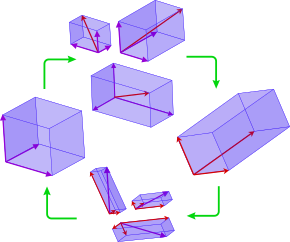Change of basis
The change of basis or the basis transformation is a term from the mathematical subfield of linear algebra. It refers to the transition between two different bases of a finite dimensional vector space over a field. This change in general, the coordinates of the vectors and the imaging matrices of linear maps. A change of basis is thus a special case of a coordinate transformation.
The change of basis can be described by a matrix which change of basis matrix transformation matrix or transition matrix is called. This can also be the coordinates with respect to the new base to calculate. If you compare the base vectors of the old base as linear combinations of vectors of the new basis is, the coefficients of these linear combinations form the entries of the change of basis matrix.
Change of basis matrix
It was a -dimensional vector space over the field (for example, the field of real numbers ). In two ordered bases are given, and. The change of basis matrix for the change of basis from to is a matrix. It is the projection matrix of the identity mapping on with respect to the bases in the prototype and in the picture:
They are obtained by representing the vectors of the old base as linear combinations of the vectors of the new base:
The coefficients are the th column of the change of basis matrix
This matrix is square and invertible and thus an element of the general linear group. Its inverse describes according to the change of basis from back.
Special cases
An important special case is the case, that the vector space is consistent with the coordinate space of the same. In this case, the basis vectors are column vectors
To the matrices
Can be summarized, which are referred to here for simplicity with the same letter as the corresponding bases. The condition
Then translated to be
That is,
The transformation matrix can be achieved by thus
Calculate the inverse matrix of the matrix.
In particular: Is the standard basis, the following applies. Is the standard basis, the following applies. Here, as in the foregoing, the base will be identified with the matrix, which is obtained by writing the base vectors and column vectors, and combining these to form a matrix.
Coordinate transformation
A vector I h respect to the base coordinates, d
And with respect to the coordinates of the new base so
If, as above, the vectors of the old base as a linear combination of the new base is, we obtain
Here, the above-defined entries in the change of basis matrix. By comparing coefficients obtained
Or in matrix notation:
Or in short:
Base change in imaging matrices
The matrix representation of a linear map depends on the choice of bases in the original image and the target area. If you choose other bases, we obtain other imaging matrices.
Be one -dimensional and one -dimensional vector space over and a linear mapping. In are the parent bases and if, in the ordered bases and. Then for the representation matrices of respect and regard and or:
You will get this representation by
Writes. The imaging matrix of the concatenation is then the matrix product of the individual imaging matrices when the bases are chosen to match, ie: the base in the preimage of the base in the image of and in the preimage of the base in the picture and in the inverse image of, and the base in the image of. One thus gets:
An important special case is when an endomorphism and the prototype image and each has the same base or used. Then:
So Substituting, the following applies
The imaging matrices and are thus similar.
Example
We consider two bases and with
And
The coordinate representation of the vectors, the vectors described with respect to the standard basis.
The transformation of the coordinates of a vector
Results with the representation of the old basis vectors with respect to the new base and their weighting.
To calculate the matrix of the basis transformation from to, we need the three linear systems of equations
Solved for the nine unknowns.
This can be done using the Gauss-Jordan algorithm for all three systems of equations simultaneously. To the following linear equation system is set up:
By forming with elementary row operations can be brought to the unit matrix, and on the right is obtained as the solution of the system, the transformation matrix, the left side
We consider the vector, ie the vector of the coordinates relative to the base
Possesses. To calculate the coordinates with respect to, we need to multiply the transformation matrix of this column vector:
So is.
In fact, one expects as a sample is easy to check that
Applies.
Applications
Basiswechselmatrizen have a variety of applications in mathematics and physics.
In mathematics
An application of Basiswechselmatrizen in mathematics is the change in shape of the image matrix of a linear mapping, in order to simplify the calculation.
If you want, for example, the power of a matrix calculated with a exponent, then the number of required matrix multiplications of the order. Is diagonalizable, then there exist a diagonal matrix and a change of basis matrix, so that, thus
The number needed for the computation of the right side only of the order of multiplication is:
- To calculate,
- For the calculation of the product
- And a matrix multiplication of the product
As the matrix multiplication of the scale, we obtain a complexity in place of.
In Physics
An application of Basiswechselmatrizen in physics, for example, takes place in the similarity theory to determine dimensionless numbers. This new base dimensions are assigned by a base change of a physical quantity. The dimensionless parameters, then make exactly Represents the ratio of the physical size dimension to his rule







